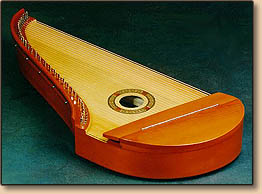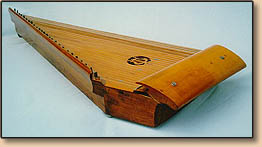About two hundred years ago the kantele underwent a major transformation when kantele-makers began to make make instruments out of separate pieces of wood. The way the strings were attached also changed: the metal rod gave way to individual metalpins and each string had its own tuning peg. By the mid-19th century there were instruments with as many as twenty strings. Nowadays the number of strings has increased to nearly forty. In the oldest box kanteles the strings radiated out like a fan, and the strings of hollowed kanteles always followed this pattern. The instrument was still almost triangular in shape, two of the sides being straight and the third (with attachment pins) either straight or rounded. Box kanteles spread all over the country.
In the Perho River Valley (Perhonjokilaakso) in Western Finland, where I live, the kantele has always had a strong tradition. The box kantele is generally tuned diatonically. Perho River Valley kanteles have their own tuning system in the bass strings. Our family have made Kanteles for many generations and we have developed our own kantele model. My grandfather Leander Laasanen had developed kanteles over seventy years, and my father Kullervo Laasanen and I have continued his work.

36-string Perho River Valley kantele, made by Jussi and Kullervo Laasanen 1998.

27-string kantele, made by Leander Laasanen at the beginning of 1900's.

Perho River Valley styled soundhole at the top of image.